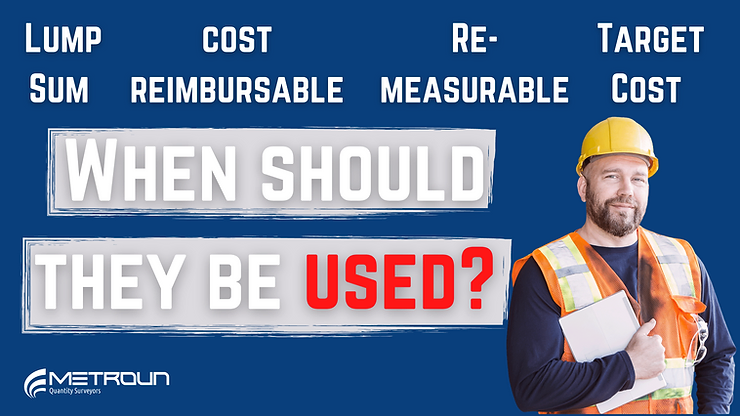If you’ve ever had construction or maintenance work carried out in your home, then you already know the different ways you can pay someone. For instance, you can pay someone an hourly or day rate, you could agree a fixed price, or you can pay a unit rate (for instance, you pay for each door to be installed, or each fence panel to be replaced).
And if you work in construction, you know the same applies, and that the contract determines the method of payment. In this article, we’re going to compare the four most popular construction contracts, discuss when they should be used and understand why.
Lump Sum
Lump sum otherwise known as fixed price, or fixed sum, or fixed lump… okay that last one was a lie, there are lots of different terms people use. However, the general concept remains the same. A price is agreed at the start of the project and the contractor is paid the agreed price. Lump sum doesn’t mean the price is unchangeable. However, variations are often limited to unforeseen circumstances or changes in scope. So under what circumstance is lump sum the appropriate contract choice?
Well, think of it this way, for a contractor to offer a fixed price for the works, they’ll need to know exactly what the works will entail. In construction you have different levels of design, from concept design to detailed design. In most cases, you’ll need to have a detailed design in place to maximise value under this contract. Otherwise, time may be spent negotiating variations which isn’t helpful to either party.
Pros to this contract include:
· Risk to the client is minimal
· Capital can be arranged according to the payment plan
· Contractor’s cash flow is predictable
· The tendering process is more transparent and impartial
Cons to this contract include:
· Contractor’s risk is high, meaning they’ll likely charge a higher fee
· If the design is incomplete, or contains ambiguities then disputes are likely
· The design often needs to be complete before tendering
· Procurement times are often elongated
Cost reimbursable
Cost reimbursable, otherwise known as cost plus. Essentially, under this option the contractor is paid actual cost for works carried out, plus an agreed fee. This type of contract is normally used when the scope cannot be properly defined when works start, and usually used when risk associated with the works are high and require immediate attention. For example, emergency work.
Pros to this contract include:
· Works can start immediately with no time spent on agreeing a price beforehand
Cons to this contract include
· Risk to the client is high as the final cost is not known when the contract is initiated
· Productivity can be low, as there is often no monetary incentive for the contractor to finish ahead of schedule
Re-measurable
Re-measurable contracts, otherwise known as measurement contracts or unit price contract. Under this contract, payment is made against an agreed schedule of rates. Each month a valuation of work is undertaken using the agreed schedule of rates and site measurements.
This contract is used when the scope of works can be described in detail, but the quantities or amount cannot. For example, under term maintenance contracts, the maintenance work required maybe fairly repetitive and therefore easy to cost for. However, the amount of work required is unforeseeable. This contract type may also be appropriate when design for a project contains insufficient detail for a bill of quantities to be produced.
Pros to this contract include:
· Works can start without a detailed design and complete BoQ
· Potential reduction in design cost
· Prices (or unit rates) are competitive
· Increased possibility of value engineering
· Contractor’s risk is comparatively low
Cons to this contract include
· Client has no assurance of final cost of project
· Higher administration required to assess and measure works
· Client’s risk is comparatively high
· Potential cash flow issues for contractor if work output required is low
Target Cost
You could say this contract is a hybrid of both lump sum and cost reimbursable. Essentially, a contractor will be reimbursed for the actual cost on an interim basis similarly to cost reimbursable. However, what makes target cost different, is that financial gain and financial loss is shared between the client and contractor using a percentage split agreed at pre-contact stage. This is calculated by taking the agreed price and deducting the actual cost incurred, the difference is then split between parties by the agreed percentages (sometimes this is 50/50). The agreed price may be changed through variations during the project. Financial gain or pain is usually calculated once works are complete and reflected in the final payment/ final account.
Pros to this contract include:
· Both the contractor and client is inclined to work collaboratively as they both share the same financial incentive
· The contractor is inclined to work productively to reduce risk of financial loss
· Contractor is motivated not to overspend by finding innovative ways to complete the project
Cons to this contract include
· Contractor may try to use products that are cheaper and lower in quality to maximise profit
Why not watch our video on the topic:






